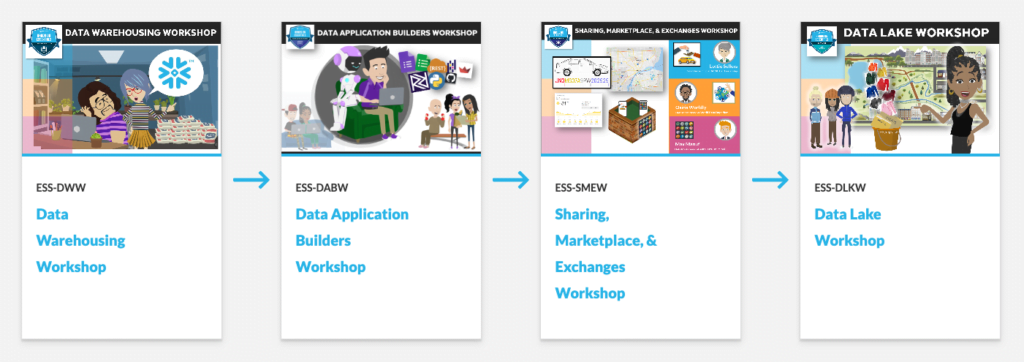No need for cold feet! Set your first 3 steps into the snow with Snowflake University to become a stone cold Snowflake pro.
So, you’ve decided to use Snowflake as your data storage and analytics platform. Maybe it’s because of Snowflake’s flexibility and scalability, the fact that it’s cloud native and because of how easily it handles semi-structured data like JSON or XML. Or maybe you’re still on the fence and you would like to know more about some interesting Snowflake features (tip: my colleague Gaia wrote this blog you could read).
Either way, if you want to learn about Snowflake’s possibilities and become an avid Snowflake user, Snowflake University is a great place to start. Here, Snowflake offers two different learning tracks to better understand the Snowflake ecosystem, before going more in-depth and working your way up to certification. But first, simply go to https://learn.snowflake.com/tracks and create a free account.
Step 1: choose a learning path
After setting up your account, it’s time to choose your preferred method of learning. If you’re entirely new to the Snowflake ecosystem, the Snowflake Essentials course might be the way for you. In four hands-on workshops, each of which awards you with a nice and shiny badge after you complete it, you will be introduced to many of the possibilities Snowflake has to offer. From basic data warehousing tasks, to creating automated API data flows, and building web pages using several partner integrations and much, much more.
The workshops use animated storytelling, introducing you to some new data friends that you’ll learn to love. They’ll help you better understand Snowflake’s many use cases, as well as guide you through Snowflake’s brand new interface. So, if discovering the true extent of Snowflake’s possibilities is what you’re after, be sure to choose this track.

However, if you prefer a more direct, factional approach, you may want to choose the Level Up-track. During the course of eleven chapters in total, Snowflake provides you with everything you need to know about its history as well as its basic principles and functions. Just as with the Essentials course, your knowledge is tested continuously with multiple choice questions you need to answer in order to progress. And even though you do not receive a badge as proof of learning, with the Level Up-track you do learn a lot.
Step 2: Set up your Snowsight account
When you have chosen whichever path you prefer, it’s time to put the theory into practice. In order to do so, you need to create a trial account for Snowsight (the Snowflake web interface) on https://app.snowflake.com. Snowflake offers you a free 30-day trial period to get to know the Snowsight environment, but encourages anyone to apply for another trial account using a different email address if needed. Carefully follow the steps in the learning path to make sure you get the configurations (Cloud Platform Provider, Geographic Region, and Snowflake Edition) right. Especially for the Essentials course, this is important.
Be aware that the accounts for learn.snowflake.com and app.snowflake.com are two completely different entities, even if you use the same email address to set them up. You keep track of your learning progress on the Learn-account, whereas the Snowsight account is there to be able to carry out the tasks on hand. In order to get the badges and learning credits, you will need to link them. Whenever your first Snowsight trial ends, you can link your second or third account to your Learn-account as well, to track your progress.
Step 3: Get certified
Finally, when you feel that you’ve got the gist of it, you may consider getting certified. For Snowflake, you should be striving to attain the SnowPro Core. The exam consists mainly of theoretical questions about the Snowflake ecosystem, its structures, and unique features. My colleague Atzmon recently wrote a blog about his experiences preparing for the SnowPro Core certificate.
One thing to keep in mind is that while the SnowPro Core exam extensively tests your knowledge about Snowflake, you do not require any technical skills or SQL savviness to obtain the certificate. In order to be able to really use Snowflake to its full potential, you need to get your hands dirty. Or should I say, get your hands cold?
Bonus step: Frosty Fridays
If you want to dive deeper into Snowflake and (further) develop your practical skills, Frosty Friday will soon become your favourite day of the week. Each Friday, a new practical challenge is posted. These are typically based on one Snowflake feature; from time travel, to pipes, from data transformation to streams. As of yet, there are 25 challenges to get you started, ranging from beginner to advanced levels, with new challenges posted every week. Join the Frosty Friday community and register on https://frostyfriday.org/.
Check out our blogs page to view more blogs on Tableau, Alteryx and Snowflake.
Work together with one of our consultants and maximise the effects of your data.
Contact us, and we’ll help you right away.


